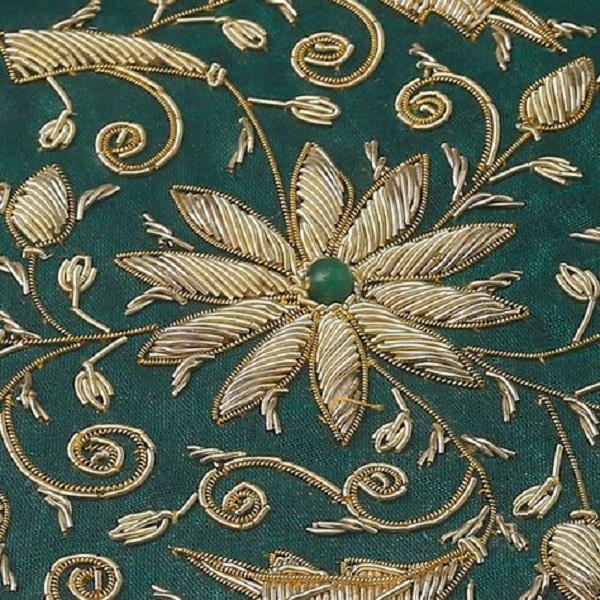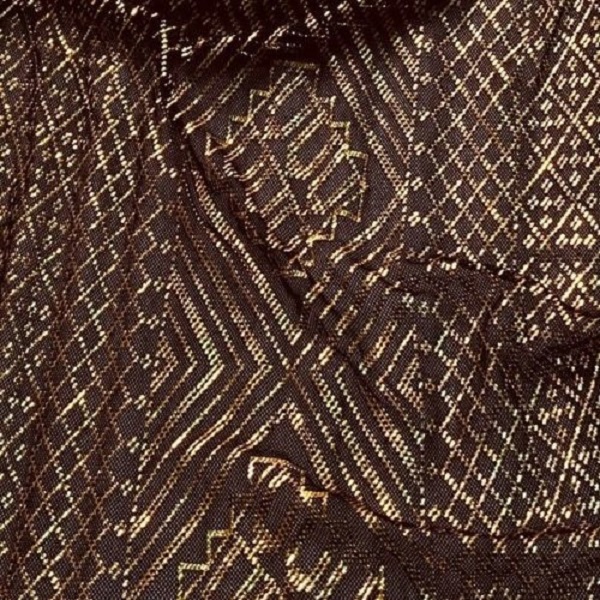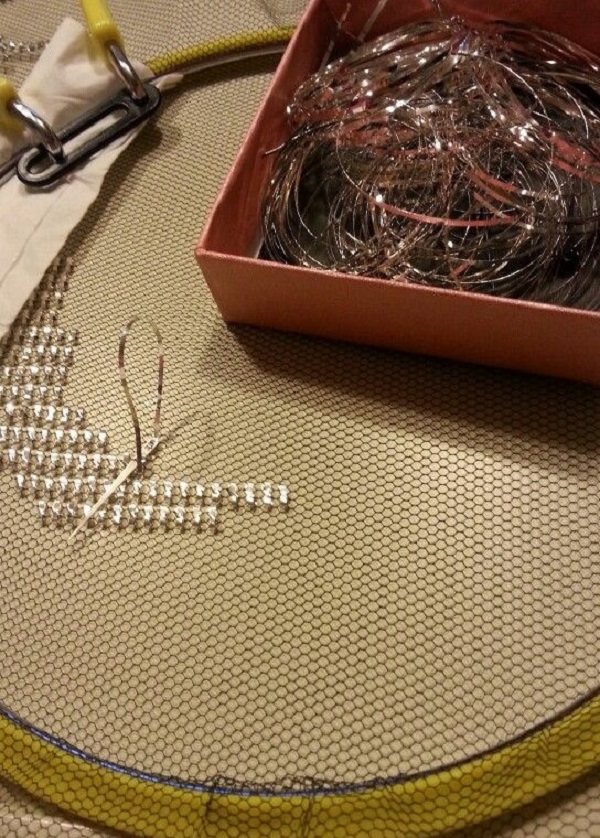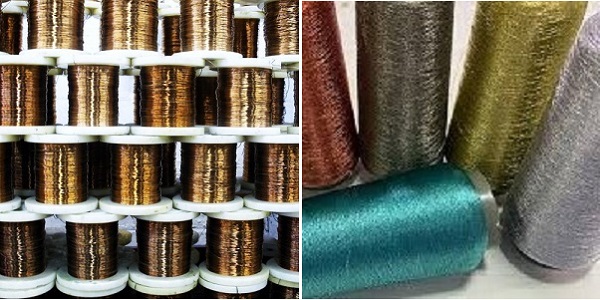The diversity of the Arab world- stretching from Mauritania to Syria to Oman and Somalia – means Metal Thread Embroidery is described in a variety of names and terminology, depending on the region and style. As these distinct regions function within the cultural meta-system of the ‘Arab World’, techniques, materials and designs blend and influence each other. In this first article in our series, we look at all the various influences and styles, as well as the history and context in which metal thread embroidery is used in and around the Arab world.
Metal Threads (Zari)
Historically, metal thread embellishment has been used extensively throughout the Middle East, Asia, and parts of Europe. Even in the Bible, we find references to its use with Egyptian linen. In the museum of Monbijou Palace in Berlin, 3,000‑year‑old specimens of netting made with flax are still preserved.
Forms of metal embellishments appeared in Egypt, Ottoman Turkey, India, and Central Asia, but in each country, it adopted a different form and is known by a different name. People from all walks of life, from royalty to laymen were and continue to be fascinated by the use of gold and silver threads.
Precious Metals
Literature reveals that gold and silver metallic coils are drawn through a series of dies to obtain a fine thread. The technique traditionally started with slabs of metal melted, beaten into thin plates, and divided into small slips which were rounded by a hammer before it was filed to form wire. Another technique was slabs of metal melted and pierced through steel sheets and hammered flat to the necessary fineness to create 2-3 mm thick metallic straw.
Precious metals such as silver or gold were first used but in time this was substituted by metal alloys plated in silver or gold, and today we have mass produced tinsel versions in a multitude of lustrous colours. The wire format is used in embroideries such as Zardozi, Sarma, and Mukaish (those are in flat straw form) where the wires can be stitched into a variety of patterns and motifs.
Due to the industrial revolution and the invention of the electroplating process, imitation techniques were developed to avoid the cost of precious metals. As copper is the most malleable and ductile metal after gold and silver, silver electroplated copper wire replaced pure silver. Various modern colours and chemicals are used to impart multiple shades of golden hue to these threads to imitate pure gold.
Gilded Threads
Due to the growing demand for precious metals and copper used in various modern industries, this option became expensive as well. Thus, a cheap and durable alternative was invented. Metallic zari (gilded thread) came into vogue replacing traditional metals like gold, silver, and copper. This modern zari, or imitation metal thread, is lightweight and more durable than earlier editions and it is resistant to tarnishing and knotting.
Zari is made when copper wires are drawn from copper alloys and electroplated with silver before it is wound around a, usually cotton, base yarn and reeled. This type of gilded thread zari is less expensive than pure metal thread zari, as silver electroplated copper is more economical.
The Indian Sub-continent
Metal thread embroidery has been around in the Indian subcontinent since the Rig Veda era (1500 BCE) and went on to prosper during the Mughal period (1526 – 1857). This kind of art goes back in history and is associated with famous Vedic texts, such as the Ramayana and the Mahabharata.
Initially, real silver and gold were used to make these threads. Craftsmen have different ways of polishing the thread to make it appear brighter and include a huge spectrum of colours including silver metallic, gold metallic, and rayon metallic.
Surat, in Gujarat, is the biggest metallic thread manufacturer in India with several distributors selling these threads on a large-scale basis across the country and continues to be the major exporter of raw materials, especially to the Arab Gulf region
Terminology
Metal thread embroidery techniques can be divided into three categories
- Surface embroidery, where the metal threads are applied on top of the fabric, such as couching
- Woven embroidery, where the metal thread is threaded through the fabric and becomes part of the structure of the fabric, known as brocade
- Applied embroidery, where the metal thread is used to create a notion or embellishment that is applied to a garment as decoration.
Metal threads and metal thread embroidery is named using different terms and terminology in different parts of the world.
Talli as we define it in our Digital Dictionary is a term believed to originate from Arabic: talā’ or talā: paint or to coat, or from Turkish: tel: wire. It generally refers to metal alloys coated with silver or gold, to create either flat straws or coil threads that are then applied on clothing in varying patterns. There is a huge spectrum of terms and variances that are used depending on location:
- tur_bi_tallī/tulle_bi_talli, asīūṭī,
- mnaqad/mnaghad, where the (qāf) is pronounced (gha) colloquially
- Naqdah: (Arabic term for coins) Since silver was a form of currency, it came to refer to silver adorned garments. Therefore, the term refers to articles decorated with silver (tallī) straw (khūs) in small coin-like dots.
Persian terms
- Zārdozī / khus_dozi (Persian: zar: gold, dozi: embellishment)referencing metallic thread embroidery.
- The Turkish term Sarmah refers to raised metallic thread embellishment
Indian terms
- Mukaish, seen often accompanying Chikankari embroidery native to Lucknow.
Where the unadorned wire is referred to as Badla, the thread wounded around is called Kasav, from qasab
- tiny spangles are called Sitara
- and the specks or dots which are made from the wire are called Mukaish or Fardi
In the next article in this series, we will look at Surface Embroidery in more detail.









Latest Comments
POST YOUR OPINIONMetal Thread Embroidery in the Arab World – Goldwork - The Zay Initiative
June 23, 2022[…] Read the first article in this series here. In the third and final article of this series, we are exploring Woven Embroidery and Embellishments. […]
Metal Thread Embroidery in the Arab World – Embellishments - The Zay Initiative
July 14, 2022[…] last in our three-part series on metal thread embroidery. The previous two articles can be found here and […]
Textiles in UAE dress - The Zay Initiative
September 15, 2022[…] are known by the name of the type of embroidery or embellishment applied to them, for example, zarī, an Indian term referring to the metal thread and embroidery […]